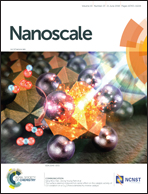The surface plasmon-induced hot carrier effect on the catalytic activity of CO oxidation on a Cu2O/hexoctahedral Au inverse catalyst†
Abstract
The intrinsic correlation between an enhancement of catalytic activity and the flow of hot electrons generated at metal–oxide interfaces suggests an intriguing way to control catalytic reactions and is a significant subject in heterogeneous catalysis. Here, we show surface plasmon-induced catalytic enhancement by the peculiar nanocatalyst design of hexoctahedral (HOH) Au nanocrystals (NCs) with Cu2O clusters. We found that this inverse catalyst comprising a reactive oxide for the catalytic portion and a metal as the source of electrons by localized surface plasmon resonance (localized SPR) exhibits a change in catalytic activity by direct hot electron transfer or plasmon-induced resonance energy transfer (PIRET) when exposed to light. We prepared two types of inverse catalysts, Cu2O at the vertex sites of HOH Au NCs (Cu2O/Au vertex site) and a HOH Au NC–Cu2O core–shell structure (HOH Au@Cu2O), to test the structural effect on surface plasmons. Under broadband light illumination, the Cu2O/Au vertex site catalyst showed 30–90% higher catalytic activity and the HOH Au@Cu2O catalyst showed 10–30% higher catalytic activity than when in the dark. Embedding thin SiO2 layers between the HOH Au NCs and the Cu2O verified that the dominant mechanism for the catalytic enhancement is direct hot electron transfer from the HOH Au to the Cu2O. Finite-difference time domain calculations show that a much stronger electric field was formed on the vertex sites after growing the Cu2O on the HOH Au NCs. These results imply that the catalytic activity is enhanced when hot electrons, created from photon absorption on the HOH Au metal and amplified by the presence of surface plasmons, are transferred to the reactive Cu2O.



 Please wait while we load your content...
Please wait while we load your content...